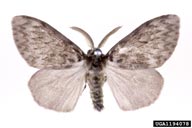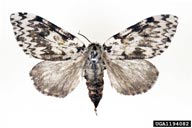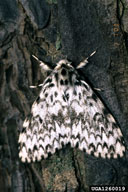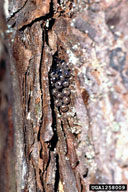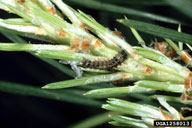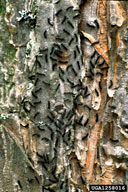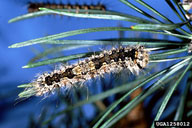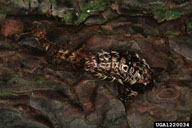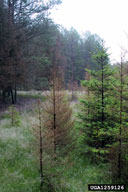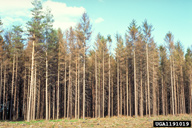Nun moth
Lymantria monacha Moore (Lepidoptera: Lymantriidae)
Orientation to pest
Nun moth, Lymantria monacha Moore, is a Eurasia species that has not yet invaded North America but is a species of high concern. Outbreaks of the nun moth are often observed in Scots pine (Pinus sylvestris L.) and Norway spruce stands (Picea abies [L.] Karst.), but many conifers and broadleaf trees are also hosts. The biology closely resembles that of the gypsy moth (Lymantria dispar [L.]), except that females of nun moth can fly, which they do at night. The species overwinters as eggs containing fully developed larvae, which emerge when buds on host trees are opening. Young larvae feed on buds in groups but after the first instar, larvae consume mature needles and feed alone. Pupation takes place on the host tree and by mid-summer adults are in flight. Adults lay eggs in cracks of bark on the host tree or in crevices of other objects in masses of 70 to 300 eggs. Egg masses may be moved on firewood or other material. There is one generation per year.
Hosts commonly attacked
Outbreaks of the nun moth are often observed in Scots pine (P. sylvestris) and Norway spruce (P. abies) stands. However, most conifers and many broad-leaved tree species may also be used as food plants.
Distribution
Nun moth is widely distributed and is found in China, Japan, Russia, and Europe.
Images of nun moth
| Figure 1. Adults of nun moth, Lymantria monacha, male left and female right (note, this species has a wide range of color variation, which is not captured in these photos) | Figure 2. Adult female nun moth in resting position | Figure 3. Egg mass of nun moth |
| Figure 4. Young larvae of nun moth (note, like adults, larvae vary in color) | Figure 5. Mature larva of nun moth | |
| Figure 6. Pupae of nun moth | Figure 7. Small conifer killed by nun moth | Figure 8. Norway spruce stand defoliated by nun moth |
Important biological control agents related to this pest species
Many natural enemies have been recorded attacking nun moth, usually during outbreaks or in the decline phase as populations collapse. These include many species of parasitoids (mostly tachinid and sarcophagid flies and braconid wasps). See Van Driesche et al. (1996) for details. A baculovirus is also known from this species. However, there is limited experimental evidence about the role such agents play in regulation of the species or curtailment of outbreaks.
Web links for information on nun moth
- BugwoodWiki Article | http://wiki.bugwood.org
- Fact Sheet | United Nations FAO group
- Fact Sheet | Canadian Food Inspection Agency
- Forest Disturbance Processes: Nun Moth | USDA Forest Service, Northern Research Station
Information on the species' biology, photos, a reference list, and a pest alert
Articles
- Van Driesche, R.G., S. Healy, and R. C. Reardon. 1996. Biological Control of Arthropod Pests of the Northeastern and North Central Forests in the United States: A review and recommendation. FHTET 96-19, USDA Forest Service, Morgantown, viewable at http://www.forestpestbiocontrol.info/fact_sheets/documents/arthropodpestsnortheastern_northcentral.pdf
- Keena M. A., K. S. Shields, and M. Torsello. 1998. Nun moth: potential new pest. Pest Alert NA-PR-95-98. U.S. Dep. Agric. Forest Service, Northeastern Area, State and Private Forestry. 2 pp.
- Keena, M.A. 2003. Survival and development of Lymantria monacha (Lepidoptera: Lymantriidae) on North American and introduced Eurasian tree species. Journal of Economic Entomology 96: 43-52.
- Prestemon, J. P., J. A. Turner, J. Buongiorno, S. S. Zhu, and R. H. Li. 2008. Some timber product market and trade implications of an invasive defoliator: the case of Asian Lymantria in the United States. Journal of Forestry 106: 409-415.
